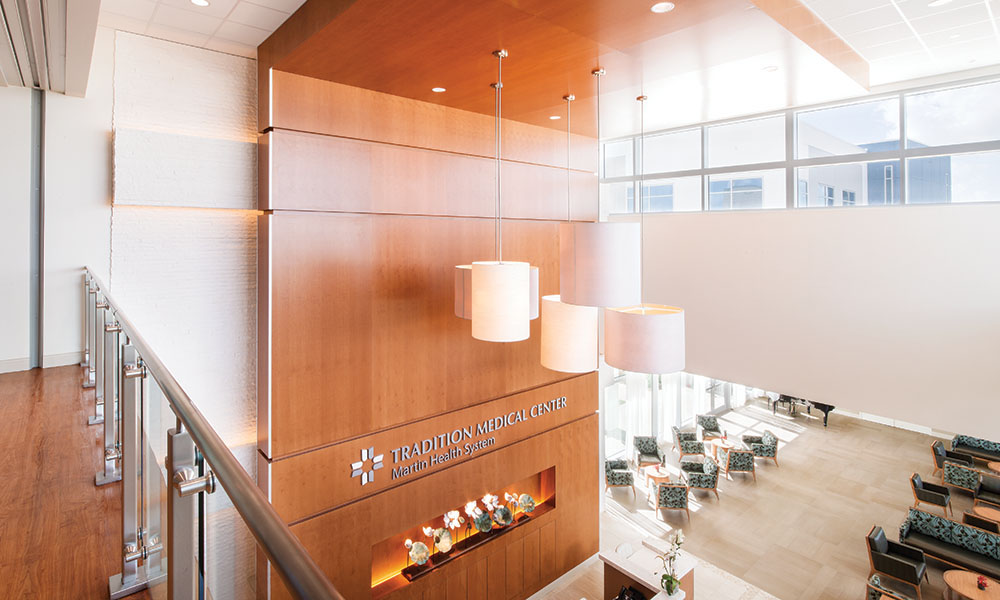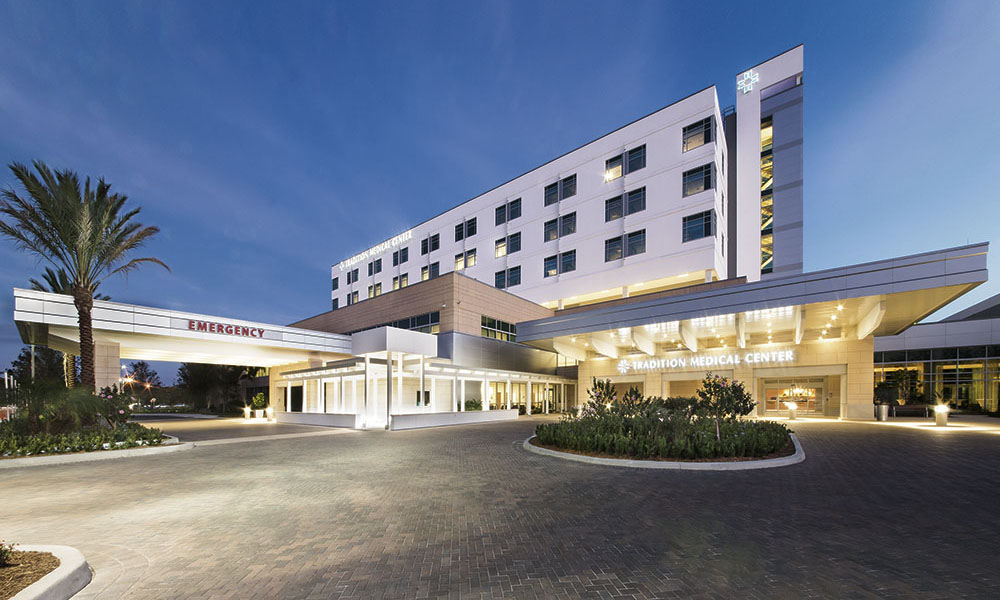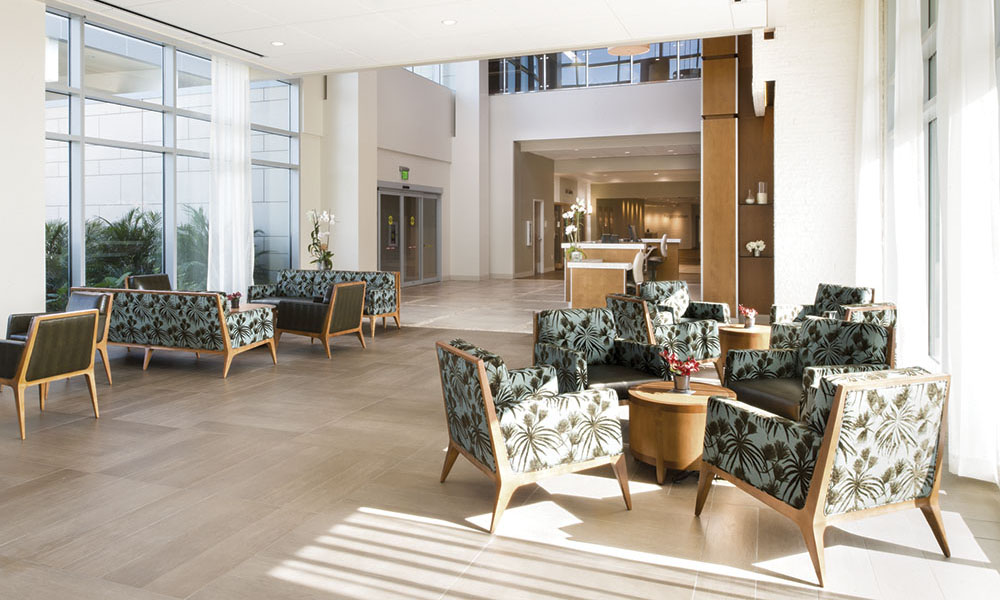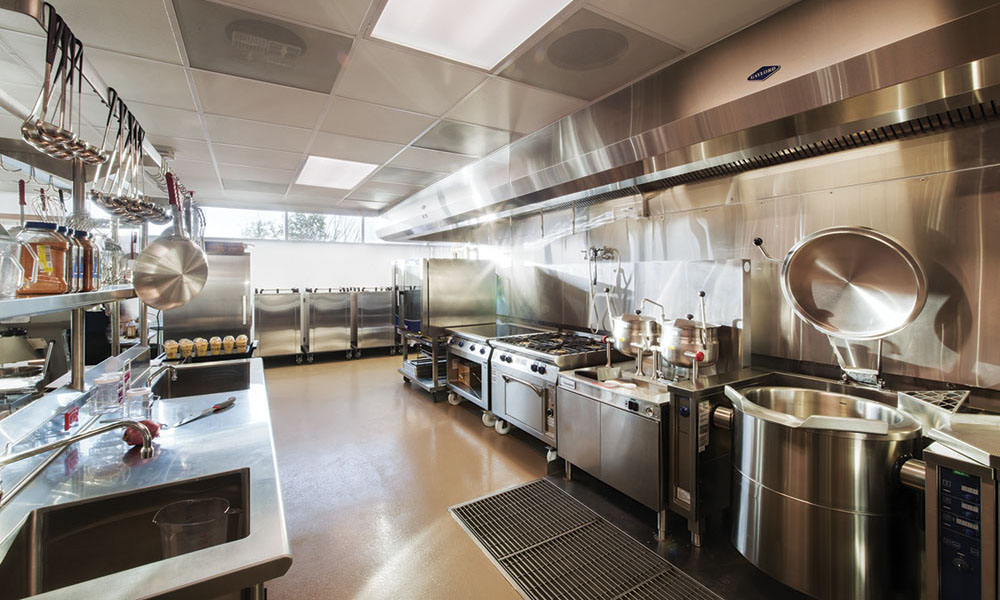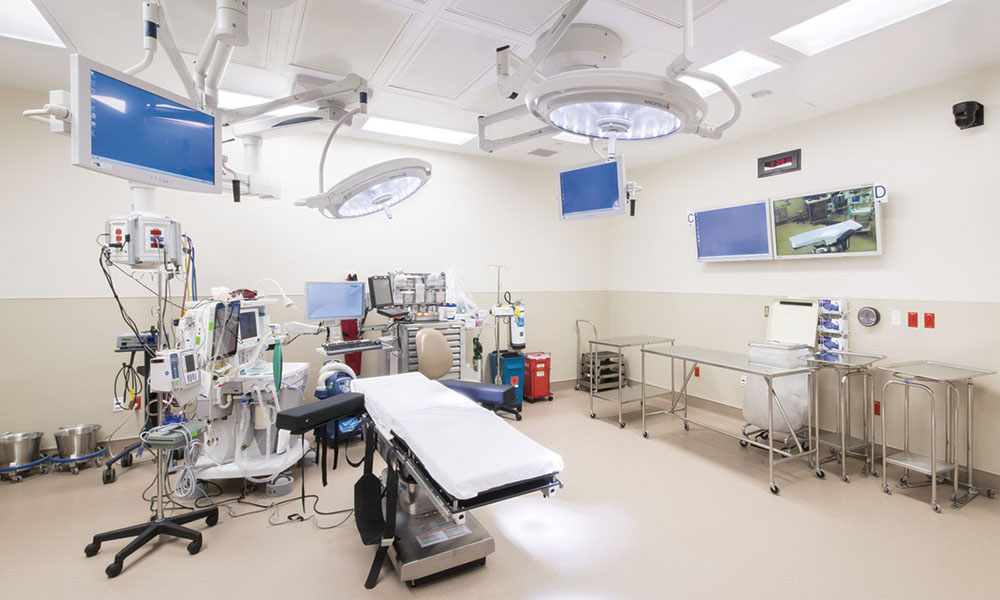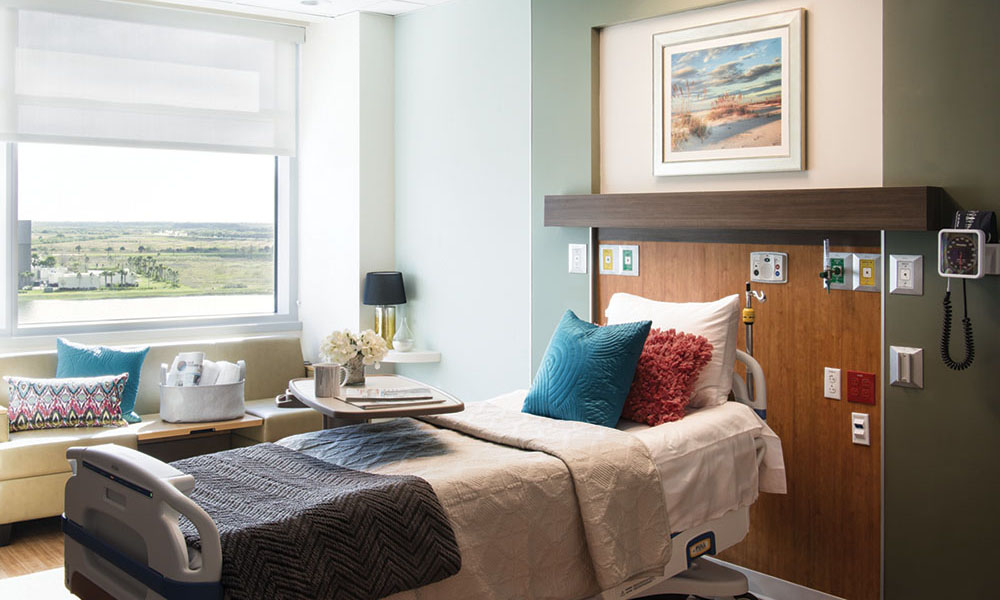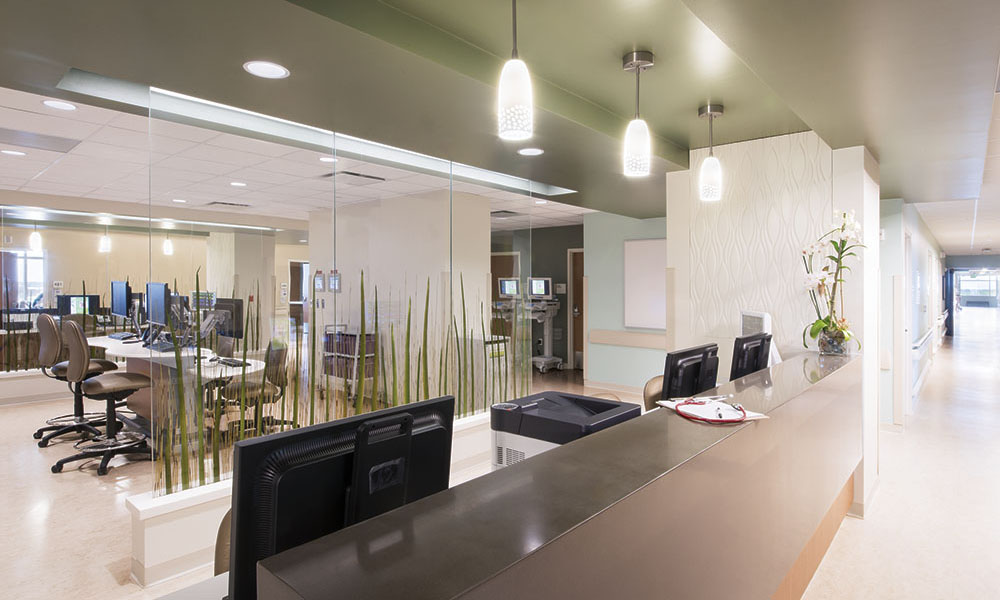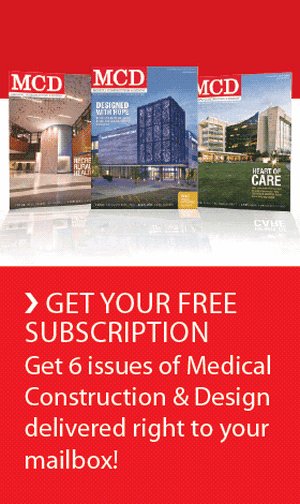Tradition Medical Center Embodies ‘Start Smart, Design Smart, Build Smart’
By Roy Gunsolus & Christian MacCarroll | Photos by Jordan Fugeman
Designed and built at the height of the recession, the 90-bed satellite hospital opened its doors Dec. 18, 2013 — on schedule, despite 63 rain days during construction, and several million dollars under budget. The medical center’s entire design and construction team, led jointly by Martin Health System, HKS Inc. and Balfour Beatty Construction, was committed to the philosophy, “start smart, design smart, build smart.” The project was based on collaboration, Lean design and building an efficient facility responsive to changing needs.
Martin Health System initially conceived of Tradition Medical Center in 1998, when demographics indicated a burgeoning demand for a hospital in Tradition, Fla., a master-planned community in Port St. Lucie. At the time, the local and U.S. economies were booming. By 2010, once the lengthy certificate of need approval process was completed, the economic outlook had changed substantially. Few health systems were building; most were waiting out the recession, as well as uncertainty over the impact of national health reform on medical reimbursement. Questions were raised within MHS about moving forward with the project. The health system’s leaders accurately predicted this was the perfect time to proceed, as projects were scarce and the design and construction market was extremely competitive.
MHS was also savvy in fostering an integrated team approach that encouraged collaboration. Rather than conducting independent, one-hour interviews with architect and construction manager candidates, as is standard, the health system held two collaborative half-day workshops to see how the architects and construction managers worked together and whether they resonated with key hospital stakeholders. The format was loosely defined, to give MHS an indication of what the candidates prioritized and whether they felt comfortable working as a team over a two- to three-year construction time frame. MHS ultimately selected HKS and Balfour Beatty Construction, and the three organizations signed a tri-party (owner/architect/construction manager) contract.
Start smart: collaboration
At the outset of the project, MHS purchased a house adjacent to the health system’s main medical campus specifically for the design and construction team to use. All user meetings and team meetings occurred there. Hoteling workstations were provided for all project team members, and plans, renderings and project schedules were posted for reference.
To gain an understanding of likes and dislikes in hospital design, MHS representatives visited similar-sized hospitals with key design and construction team members. These site visits were used to develop design parameters summarized on an A3 report, a single-page document meant to streamline decision-making and improve communication.
The project team established specific conditions of satisfaction and a values matrix that were referenced throughout design and construction. The wide-ranging matrix included items like environmentally responsible design, future flexibility and creating a learning environment to promote an atmosphere of continuous improvement.
Component teams met regularly to ensure specific areas of the project met quality and budget parameters. Each of the following areas was overseen by a multidisciplinary team: exterior envelope and structural engineering, site, interiors, technology, mechanical/electrical/plumbing and sustainability and schedule and general conditions. “Bartering” among teams was allowed, as long as all parties agreed and the overall budget was maintained.
As important milestones were achieved, MHS hosted celebratory cookouts for the project team to further encourage camaraderie and collaboration.
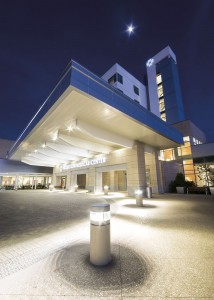
Architectural elements aid in wayfinding. The campanile serves as a beacon to guide visitors from afar, and delivers them directly to the front door.
Design smart: Lean design
Lean design and project management techniques helped the team meet MHS’s goals for the facility. For example, to satisfy the health system’s target date for opening the hospital, all key stakeholders were involved in flexible scheduling sessions that used pull planning, a system of working backwards from critical end dates to establish a final schedule.
The team leased warehouse space to mock up areas such as a medical/surgical patient room, intensive care unit room, emergency department exam room and surgical operation room.
Construction was made easier by the design’s simple, rectilinear geometries, which support efficient layouts and workflows. Blocking and stacking studies helped determine adjacencies. Integrated programming and planning ensured the design optimized operational efficiency; the design team listened to hospital staff to determine the best layout to meet their needs.
The surgical prep/recovery area, for example, is designed with swing bays that can flex between prep/phase II and post-anesthesia care. Induction rooms are provided for anesthesia blocks, to expedite time in the operating room. Endoscopy is located adjacent to the prep/PACU area, to share space, create more flexibility and enhance staff efficiency.
In the surgical department, a sterile core is designed to be used as setup space for the operating rooms, to expedite throughput; direct access from this area to the ORs provides quick instrument turnover. Shelled space can be used for a future interventional suite or additional ORs.
Intensive care, step-down and medical-surgical patient rooms utilize the same footprint, for future flexibility. All patient rooms have dedicated linen and supply closets that nurses can access easily, to minimize nurse travel time. Team centers are included on the patient units for staff collaboration.
Build smart: Designing and building with a purpose
The building is sited to maximize views to nature, especially from patient rooms and public spaces like the lobby and dining area. Eastern and western exposures are minimized to promote energy savings. Separate public and service access roads optimize site circulation.
The hospital is well integrated into both the city of Tradition and the area’s newly developed research park, the Tradition Center for Innovation. In addition to Tradition Medical Center, the research park includes the Torrey Pines Institute for Molecular Studies, the Vaccine and Gene Therapy Institute of Florida and the Mann Research Center. These biotech medical partners are co-located around a 25-acre lake, to foster collaboration, entrepreneurship and medical advancement. The other buildings in the research park generally have a human-scaled base, a technology focus in the middle and treatment or research areas at the top. The hospital emulates this design idea, with an articulated diagnostic and treatment podium, mechanical mezzanine middle and patient-bed floors above.
The city of Tradition is a new urban area with a nostalgic, old town feel, in which tower elements are used as wayfinding aids. The hospital features articulated fenestration and detailing, as well as a stair tower to facilitate wayfinding and accentuate the main hospital entrance.
Natural light and views to nature were introduced to accelerate healing, reduce medical errors and enhance wayfinding inside the facility. The corridors of the hospital’s bed tower and diagnostic and treatment block terminate in views to nature, rather than additional rooms or stair towers.
The architects led a sustainability charrette prior to design, during which the team prioritized sustainable initiatives and established energy targets for annual energy use and lighting power density. The MEP component team reduced the hospital’s lighting power density to 0.69 watts per square foot, well below the 1.2 watts allowable by code. In addition, energy use was reduced to 31.3 percent better than code, through the implementation of a heat recovery chiller, energy recovery ventilators, reflective roofing, high-quality glazing and condensing water boilers. The project has been submitted for LEED Gold certification.
A mechanical mezzanine level located between the diagnostic and treatment “podium” and the bed tower frees up valuable floor area for patient care. Three additional bed floors can be accommodated vertically. The surgery, imaging, ED and dining areas can be expanded horizontally. Elevator hoistways have been shelled for additional elevators. The building’s flexible, expandable design will provide long-term value to its community.
Author: Roy Gunsolus & Christian MacCarroll | Photos by Jordan Fugeman
Roy Gunsolus, AIA, ACHA, LEED AP BD+C, is principal/director of healthcare sustainability at HKS Architects, Inc. Christian MacCarroll, LEED AP BD+C, is senior project designer at HKS Architects, Inc.
Posted June 10, 2014
More Articles:
- Superheroes Descend on Connecticut Children’s for Groundbreaking of 8-Story Clinical Tower
- State of Industry Examined in ‘Healthcare Reset’ Report
- Cam Twohey Joins Kahler Slater as Associate Principal, Senior Project Architect in Healthcare Market
- Perkins Eastman Welcomes Michael Hess as Principal in New York Studio
- Coverings 2024
Apr 22, 2024 – Apr 25, 2024 - Hospital, Outpatient Facilities & Medical Office Buildings Summit
Apr 25, 2024 – Apr 25, 2024 - CxA Workshop & Exam
Apr 29, 2024 – Apr 30, 2024 - EMP Seminar & Exam at CxEnergy 2024
Apr 29, 2024 – Apr 30, 2024 - CxEnergy
Apr 29, 2024 – May 2, 2024 - PHCC West 2024
Apr 29, 2024 – May 2, 2024 - Lean in Design Forum 2024
May 1, 2024 – May 2, 2024


